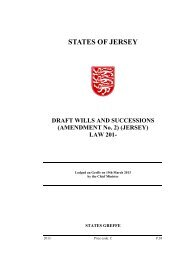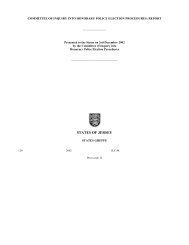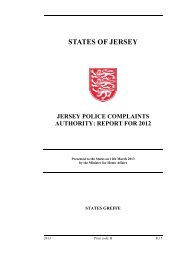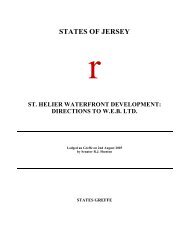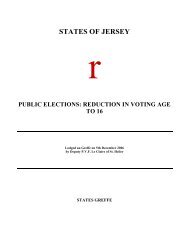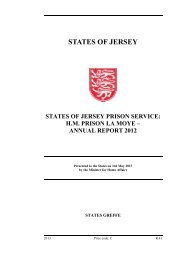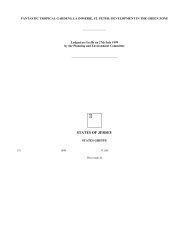Waste not want not - States Assembly
Waste not want not - States Assembly
Waste not want not - States Assembly
Create successful ePaper yourself
Turn your PDF publications into a flip-book with our unique Google optimized e-Paper software.
Box 26: Department of Health evidence on the health effects of the<br />
incineration of municipal solid waste: 117<br />
●<br />
●<br />
●<br />
A report on “Health effects of waste combustion products” published in 1997 by the Medical<br />
Research Council Institute for Environment and Health concluded that epidemiological studies<br />
of people who work or live near incinerators have shown no consistent excess incidence of any<br />
specific disease.<br />
Similarly, a report on waste incineration and public health published in 1999 by the US<br />
National Research Council, concluded that “few epidemiological studies have attempted to<br />
assess whether adverse health effects have actually occurred near individual incinerators, and<br />
most of them have been unable to detect any effects.” The studies which did report any<br />
health effects had shortcomings and failed to provide convincing evidence.<br />
The independent advisory committee on the carcinogenicity of chemicals in food, consumer<br />
products and the environment has considered studies on cancer incidence near municipal<br />
solid waste incinerators. It considers that any risk of cancer due to residency near to municipal<br />
solid waste incinerators is exceedingly low and probably <strong>not</strong> measurable using most modern<br />
epidemiological techniques. The committee said there was no further need for investigations<br />
of cancer incidence near municipal solid waste incinerators. Their statement can be found at<br />
www.doh.gov.uk/munipwst.htm<br />
These studies suggest that, while health effects can<strong>not</strong> be completely ruled out, the potential<br />
effects are so small that they are very difficult to isolate from other potential causes. Indeed,<br />
exposure to risk was hard to measure with any precision.<br />
The Department of Health states it is <strong>not</strong> aware of any subsequent epidemiological studies that<br />
invalidate these conclusions. Furthermore most of these studies concern older incinerators which<br />
are now required to comply with much more stringent emissions standards.<br />
WASTE NOT, WANT NOT<br />
6.72 Despite this research and the fact that 6.74 Incineration should be treated like any<br />
emissions from incinerators are falling rapidly, other waste management approach. This means<br />
incineration continues to be the subject of a that every effort should be made to ensure that<br />
good deal of controversy. This is particularly they are well regulated. If it is the BPEO for an<br />
with respect to the potential health effects of area, and it is effectively regulated, it should be<br />
even very low levels of emissions.<br />
for local authorities to decide if they wish to use<br />
6.73 The SU’s initial review of the literature 118 this method. Although all residual waste options<br />
should be scaled to ensure they take full account<br />
suggests that whilst there are concerns about<br />
of waste reduction and recycling targets.<br />
the health effects of materials produced from all<br />
waste management facilities, the risks are very 6.75 However, building on the initial review<br />
low and difficult to measure. Like the<br />
undertaken by the SU, there is a case for setting<br />
Department of Health, the review found no up a more comprehensive evidence base on the<br />
evidence of a proven causal link between health and environmental effects of incineration<br />
incinerators and cancer.<br />
and all other waste management options to:<br />
117<br />
Department of Health<br />
118<br />
SU working paper, Enviros Aspinwall, The Context for Emissions and Health Impacts Associated with <strong>Waste</strong> Management.<br />
This is summarised in Annex J, available on SU website<br />
80




